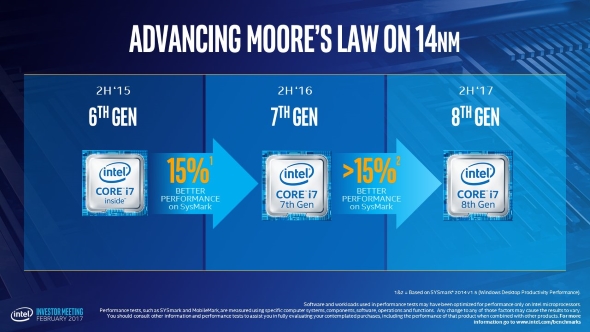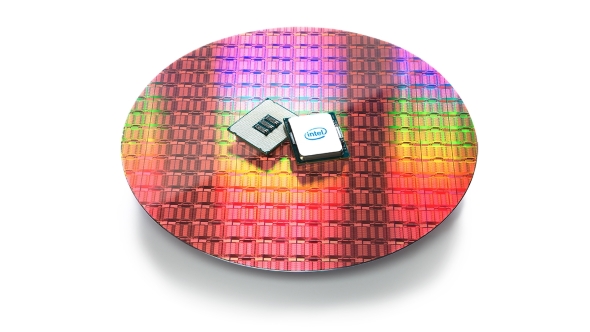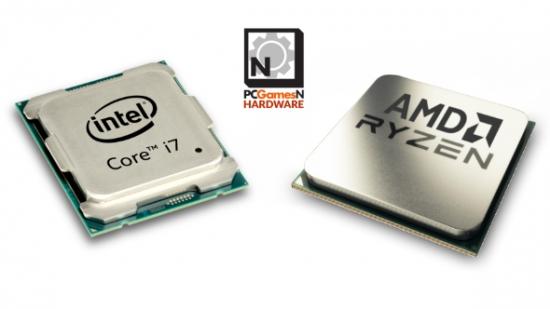A resurgent AMD has found Intel seemingly unable to cope with the prospect of genuine competition in the PC space. It’s been a long time since Intel actually had to worry about what their biggest rival in the x86 CPU market was up to, but with the launch of the AMD Ryzen chips Intel have to up their game.
Your processor can’t do all the work on its own, help it out with one of the best SSDs around right now.
Just in case you’ve had your head buried in the sand for the last six months, the upcoming Ryzen processors are the vanguard of AMD’s brand new Zen CPU architecture.
To me, Intel’s ad hoc, scattergun response to the swathes of column inches that have been written about AMD’s new chips has been ill-conceived at best and irrelevant at worst. They’ve almost given up on the recent Kaby Lake 7th Gen Core launch by talking about the 15% performance boost you can expect with the upcoming 8th Gen and missed the point of Ryzen by seemingly bringing forward their new expensive high-end desktop platforms.
What does AMD’s Ryzen offer?

The Ryzen chips represent AMD’s first ground-up processor redesign since the failed gamble on their Bulldozer CPUs, and it’s a massive one for that side of AMD’s business.
With Ryzen they’re still aiming to boost the core/thread count for mainstream processors, but in contrast to the ‘dozer design AMD are also focusing on making sure the single-threaded performance is capable of delivering quality gaming performance to compensate for a lack of genuine multi-threading support in many modern game engines.
You may have heard about an instruction-per-clock (IPC) increase of around 40% with Zen; that’s AMD making sure we know they’re putting a big emphasis on ensuring each individual Zen core has enough processing logic to power through instructions independently of other cores in the chip.
AMD then is looking to match Intel’s current dominance in the single-threaded throughput game, but they’re also introducing higher core/thread counts throughout the Ryzen range. At launch there will probably only be the big-boy chips available – the eight-core/16-thread R7 1800X, R7 1700X and R7 1700 – but there are also numerous six-core/12-thread, four-core/eight-thread and straight four-core/four-thread parts filling out the Ryzen lineup.
The key to AMD’s push for Ryzen though is the pricing and positioning of these new chips. Intel have already got a range of octa-core, hex-core and quad-core CPUs – nailing a clean sweep in our pick of the best CPUs for gaming – and they’ve even got a serious 10-core/20-thread monster of a chip. They are though priced incredibly high while the equivalent Ryzen chips are coming in at around half the price.
Intel’s top eight-core/16-thread chip – the Core i7 6900K – costs around $1,000 while the AMD R7 1800X is set to retail for less than $500, offering similar performance but actually going to go head-to-head with Intel’s six-core chips in terms of pricing. That positioning is set to continue down through the stack with the sub-$200 quad-core/eight-thread R5 1400X going up against Intel’s best Kaby Lake processor, the non-HyperThreaded, resolutely quad-core $250 Core i5 7600K.
Intel’s Ryzen response

So what’s Intel’s reaction? New chips of their own, of course! There were reports of Intel prepping updated 7th Gen Core i5 7640K and Core i7 7740K processors just a scant few months after the launch of the full Kaby Lake lineup. The i7 7740K chip is set to be slightly faster than the i7 7700K, though the i5 is supposedly going to arrive with HyperThreading enabled. That would mean each of its four cores would be able to process two simultaneous instructions in the same way the Core i7 CPUs can.
But these aren’t actually replacements for the latest Kaby Lake processors – the new i5 7640K and i7 7740K are going to be the first Kaby Lake-X CPUs for Intel’s new high-end desktop (HEDT) range due to launch in August. The fact Intel seem to be accelerating the marketing push for the range would indicate they are being in some way designed as a response to Ryzen.
They will though need a new high-end foundation – an expensive X299 motherboard – and I simply can’t see them being priced to compete in any way with the first flush of Zen CPUs, at least not on a core-for-core basis. The fact there is going to be an i5 in the HEDT market for the first time is a novelty rather than anything genuinely exciting. I’m not really convinced it will come with HyperThreading either – that would make the distinction between i5 and i7 meaningless – and it’s also set to have a miserly four-core Turbo speed of just 4GHz, some 200MHz slower than the i5 7600K.
So yeah, that’s no real response to the threat of Ryzen, just Intel starting to steer the talk towards their new peak platform processors a little earlier than expected to try and steal back some headlines from AMD on the CPU side.
Intel have also been talking about the next generation of Core processors – the 8th Gen Core architecture. Given that the 7th Gen has only just landed in full Intel’s announcement of a 15% performance boost for their next architecture is an unprecedented move. Traditionally they’ve left off talking about the next-gen chips for a while after launch so people aren’t put off picking up a new CPU because of any talk of the advances of the next big shiny chip.
What else is unprecedented is the fact Intel are sticking with the 14nm process for their 8th Gen CPUs. We’re still expecting 10nm Cannonlake chips to form some part of the 8th Gen lineup, but at least on our gaming desktops we’re stuck with 14nm once more.
Gone is the old tick-tock model of CPU evolution and now it looks like Intel have killed the process>architecture>optimisation release cadence too. That little marketing fudge on the difficulty they were having hitting 10nm didn’t even last one cycle. Instead, as a result of Intel remaining on the 14nm lithography for the fourth generation in a row, it looks like they’re moving towards a process>architecture>optimise>flog-the-expired-equine release cadence.
This is Intel reacting to things rather than setting their own pace. That was where the big blue processor makers have been at their best.
Fair trade

To me it seems like Intel’s depleted marketing department is flailing around without real direction, looking for a way to respond to the huge amount of press and user excitement the AMD Ryzen chips are garnering at the moment. And it seems like they’re flailing because they’ve either forgotten or just don’t know how to deal with real competition anymore. For the last decade or so they’ve always been able to simply fall back on the fact they had the best technology, and by a relatively wide margin.
Or maybe it’s just that Intel can’t approach competition in the same way AMD believed they used to. The last time AMD had genuinely competitive processing silicon, back in the early 2000s with the Althon 64’s K8 Hammer architecture, Intel allegedly had a more aggressive approach to dealing with competition.
The Athlon 64 chips were the first to integrate the memory controller onto the chip and the first to deliver serious 64-bit performance. Intel, by contrast, were struggling with 64-bit performance penalties and the Pentium 4 architecture burning holes through people’s machines. Okay, they weren’t quite that bad, but the Netburst architecture did get super toasty.
AMD then had a technologically superior product and to compete with them they asserted Intel was engaging in anti-trust practices which saw them sabotaging AMD’s position in the market. Ex-AMD CEO, Hector Ruiz, claimed in his book (Slingshot: AMD’s Fight to Free an Industry from the Ruthless Grip of Intel) that Intel was paying huge sums of money to manufacturers to incentivise them to use Intel products over AMD. They took the fight to the courts and sued Intel.
Intel though sued back over allegations AMD had violated their x86 licensing agreement. This back and forth went on for years, until 2009 when the two companies agreed to settle between them and shut down their individual litigation. As part of this Intel would pay AMD $1.25 billion, which sounds a lot but was in reality was just half of the profit it made in one quarteralone that year.
How should Intel react?

So yeah, Intel aren’t going to look at that as a way of dealing with competition… but how did they get back to their current position of dominance? Technical innovation. They basically went back to the drawing board, drew on their vast resources of cash and genuine engineering talent, and created the best silicon.
And that’s what they need to do now.
Intel have been treading water in the CPU business for too long now. There has been no need for innovation without any real competition pushing them to innovate. Now there potentially is it’s time for Intel to start their technology motoring again. And we know they’re more than capable of it; Intel have been producing the absolute best processor architecture for years.
The news they’re introducing six-core chips to their mainstream desktop range with Coffee Lake is promising, but they need to offer more than that when AMD are going to have octa-core CPUs in the same space.
The Motley Fool have an interesting take on one of Intel’s recent announcements though. While they were busy talking about the 8th Gen on 14nm Intel was also talking data centre/server tech. A slide about data centre growth at an enterprise event had a little side-note that read ‘Data center first to next process node.’
That’s potentially exciting because the data center/server CPUs use the same architecture as the HEDT processors. The 10-core/20-thread Core i7 6950X is essentially a server part jammed into a desktop motherboard, which is why it’s a $1,700 processor.
They have though historically been behind the times in terms of processor generation since Intel started looking to the mobile market as their priority for innovation. If Intel is serious about hitting new process nodes in the data centre first then the HEDT segment could be the new home for innovation with gamers potentially looking to that market for the highest performing silicon.
If that’s the legacy of Ryzen that’s quite exciting. The prospect of a bruised Intel fighting back against the Zen upstart with serious processor innovation can only be a good thing for us PC people, especially if Ryzen starts driving down the prices of Intel quality silicon.
What do you think? Is AMD’s Ryzen going to be as competitive as the rumours and leaked benchmarks would have us believe? And if so, how do you want to see Intel react to the new CPU landscape?
